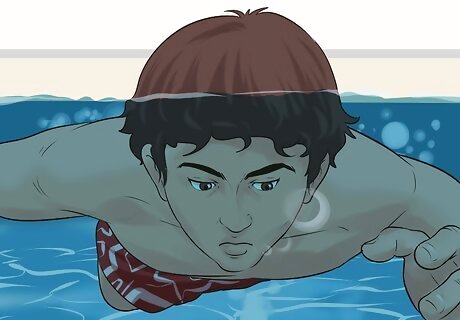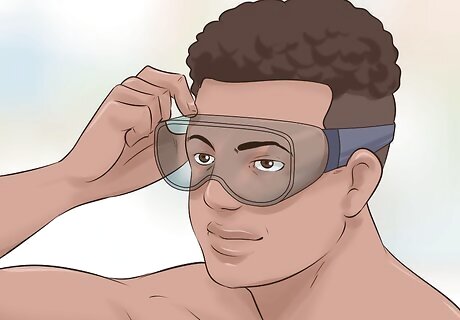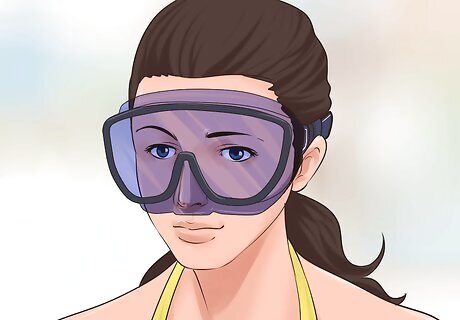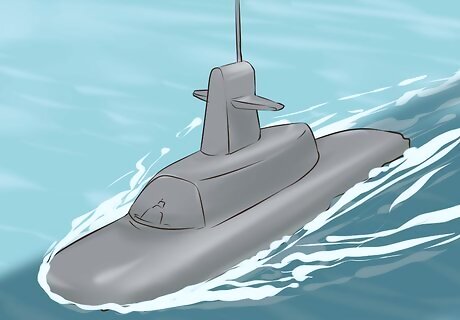
views
Opening Your Eyes Underwater

See the inside of your swimming pool. It sounds simple, but anyone who's tried it knows the sting that accompanies opening your eyes in a heavily chlorinated pool. Luckily, there are techniques available to acclimate your land-lubber's eyes to the water. If those techniques don't prove satisfactory, however, it's recommended you turn to goggles or dive masks as a tool to safely see in the pool. Practice at home by filling your sink or bathtub with water, plugging your nose, submerging your face, and then opening your eyes. Starting with water sources free of chlorine or debris will help you get use to the feeling of water on your eye, without additional discomfort. Chlorinated pools are generally kept at a safe-for-swimming pH level of 7.0 to 7.6. This effectively kills bacteria, but not the various fats and oils we bring into the pool; these accumulated bodily byproducts are common eye irritants. While exposure to normal amounts of chlorine is irritating, it will not cause permanent damage. It will, however, wash the protective tear film away from your cornea, actually making the eye more vulnerable to any bacteria which has survived the chlorinated pool. If your eyes become irritated, flush them with cool, fresh water, or utilize saline drops to ease the pain.

Open your eyes in the open ocean. Swimming in a natural source of water means no chlorine for eye irritation, but prospective eye-openers should be aware: no chlorine equals “yes” to bacteria and debris. Near the shore, waves are constantly throwing sand and small rocks toward the beach, making corneal scratches from debris a possibility. Away from the shore, you'll have a more pleasant experience looking around underwater. Careful about opening that mouth, too—while they're not all as strictly harmful as they may sound, one gulp of seawater can contain millions of bacterial cells, tens of thousands of zooplankton, and hundreds of thousands of phytoplankton.

Look under a lake. Bacteria is your major concern when opening your eyes in a freshwater lake. While it's far from a given that you'll have problems with the lake's single-cell citizens, it's recommended you use eye protection (goggles or a dive mask) when you want to see underwater. In shallower water, dirt and other hazardous particles from the lakebed can be kicked up while swimming and enter your eye. Acanthamoeba is one particular nasty amoeba that can be found in fresh water (including, rarely, tap water). Infection can necessitate a cornea transplant. Lakes do provide a more comfortable experience for opening your eyes than a chlorinated pool, though, or the turbulent shoreline of beach. If you're willing to risk it, you can probably keep your eyes open longer here than in any other body of water! The dismal visibility in a lake, however, might not provide too much to see.

Take your contacts out. In any of the above-mentioned environments, you'll want to remove your contact lenses before opening your eyes underwater. Although it's a bit of a risk for the lenses to float away (thought the water pressure will likely keep them in place), the greater danger is bacterial infection. If you wear glasses or contact, you can have your prescription put into a dive mask. Wearing a dive mask is a much safer alternative for seeing what's underwater than opening one's eyes, and is optimal for anyone who would be unable to see very well without their glasses.
Gearing Up for Undersea Exploration

Strap on some goggles. Goggles allow you to see clearly underwater without irritation, and their strap ensures they remain affixed to your head while swimming. They're secured easily: you place the lenses over your eyes, and then stretch the silicone strap around to the back of your head. The strap should press snugly against your temples, like glasses, but shouldn't hurt. A pair of goggles is only as good as its seal, so if water's getting into your lenses you might want to try a different pair. The strap and lens shape should do all the work necessary for a good seal; you shouldn't have to repeatedly fix the suction by pressing them against your eye sockets. Goggles are uniformly used by competitive swimmers, who can't have their vision compromised by going without, or their speed compromised by using the less aerodynamic dive mask. First realized in the polished tortoiseshells that fourteenth-century Persians used to protect their eyes while diving for pearls, goggles have gone through some significant improvements since then. Modern swim goggles provide excellent visibility and use plastic, silicone, and polycarbonate blends.

Wear a diving mask. A dive mask goes a step beyond goggles, covering your nose as well. If you're uncomfortable blowing air out of your nose, this means no more awkward nose-holding when you're underwater! Like goggles, dive masks are affixed to the head by a single strap, thicker than most goggles', and should remain on your face while swimming without requiring any manual application of pressure. Dive masks work because their flat surface and the space between their window and your eyes allow your eyes to focus underwater. Light bends differently underwater than in air, and the mask's design corrects this for you. Snorkels can be attached to the straps of diving masks, allowing you to float along the surface of the water with unlimited access to good, old-fashioned air. If you wear glasses, you can have your prescription put into your mask! Diving with contact lenses is also possible, though you should stick to soft lenses if you head into the open ocean. Hard lenses can suction painfully to your eyes at greater depths.

Scuba dive. Diving with the aid of an oxygen tank (or a tank filled with another appropriate, compressed gas mixture) is known as scuba diving. Divers equip themselves with dive masks, wetsuits, fins, and buoyancy compensators to aid in their underwater movement as they explore the sea floor, shipwrecks, reefs, and cave systems. Search near you for diving certification programs if you're interested! There is nuanced, particular safety information which must be learned in order minimize risk when traversing underwater environments that humans aren't designed to live in. Wetsuits absorb and retain a layer of water which your body will warm, in turn keeping you warmer. It gets cold down there! Fins provide divers with faster propulsion, which is quite necessary considering the other gear they're saddled with. Buoyancy compensation works by inflating and deflating a special vest with air, in order to control the depth at which you float in the water. Weights are also used to aid in descent. Reefs can be both natural, such as those involving large networks of coral, or artificial, when they're structures which have been created or deliberately sunk by man.
Peering Into the Ocean from Above and Below

Ride in a glass-bottom boat. Designed to allow passengers to view the water below them, the boats often tour reefs, shipwrecks, or other hotbeds of aquatic activity. Tours on these boats can be relatively affordable in comparison to other underwater exploration methods, and operate in many coastal cities and natural springs.

Board a submarine. While this isn't a repeatable option for most (outside of buying a DVD of The Hunt for Red October) seeing as personal luxury subs start at around $600,000, both military and civilian submersible vehicles routinely patrol and investigate the briny depths. Tours of non-operational military subs are possible for a window into that underwater world, however, and companies in vacation destinations often offer submarine trips to tourists. When discussing submersible platforms, HOVs are human operated vehicles, and ROVs are remotely operated vehicles. The National Oceanic and Atmospheric Administration's website contains information detailing multiple submersibles researchers use today (both HOV and ROV), including a model named “Alvin” that's been in use since 1964!

Walk the beach. Combing the shoreline for seashells, sand dollars, and sharks' teeth allows us a unique, surface-dweller's peek under the sea. It's a little eerie when you think about it, considering the majority of what washes up is dead or dying, but humanity has learned much of the sea by what's washed ashore. Indeed, until the last century, that's how we gathered most of our knowledge about the ocean. A living, adult giant squid wasn't even able to be photographed until 2012. We only knew of its existence by pieces of the squid that became stranded on the beach, or by finding them in the bellies of sperm whales that themselves had washed ashore. (As stirring as it may be, anecdotal evidence presented by ancient mariners is, unfortunately, not considered proof.) Strolls along the beach anywhere can yield once-in-a-lifetime encounters with the unfamiliar. Residents of Oxnard, California, along with other cities along North America's pacific coast were acquainted with a sea creature entirely unknown to them (and to most people) when mass quantities of by-the-wind sailors (scientific name: Velella velella) were deposited on their beaches.



















Comments
0 comment